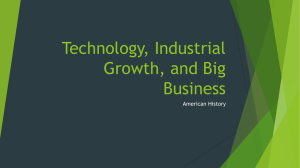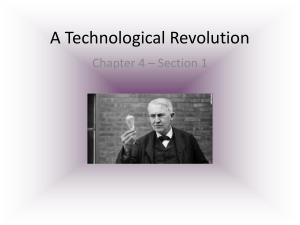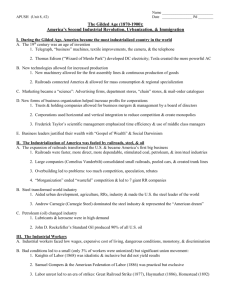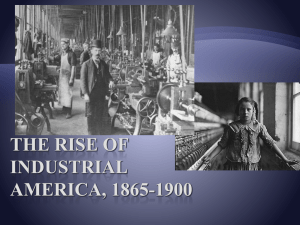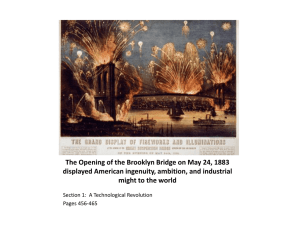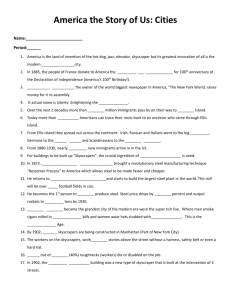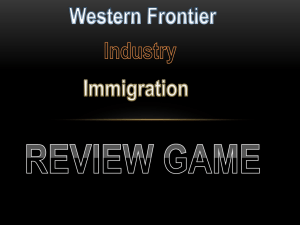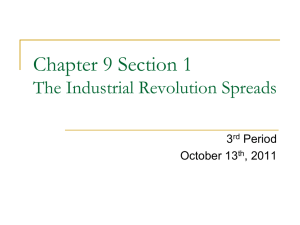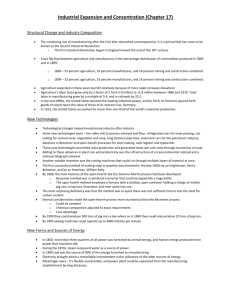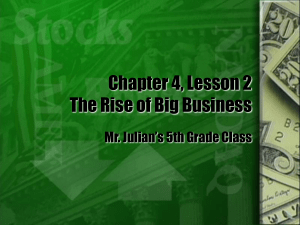Technology and Industrial Growth
advertisement
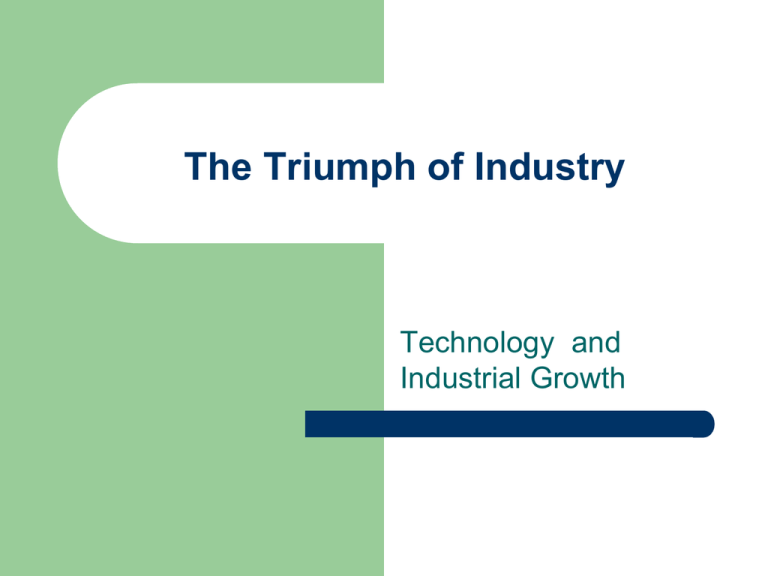
The Triumph of Industry Technology and Industrial Growth Natural Resources The country’s growth was fueled by our many natural resources. Coal mines powered trains, forests were cut for lumber, rivers were used to transports goods, and in 1859 Edwin Drake drilled first oil well. •Oil •Railroad •Mining •Marketing •Sugar •Sewing Machine •Steel •Vacuums •Meatpacking •Typewriters •Beef/Cattle •Automobile •Construction •Salt •Telegraph •Coal •Telephone •Agricultural Growing Workforce Many immigrants came to the U.S. after the Civil War. (Asians and Europeans) Push Factors- Things that push people out of their country to go somewhere else. (Religious discrimination, political war, crop failures) Pull Factors- Things that are appealing for someone who is looking for a place of refuge from their current living place. (Economic opportunity, freedom of religion, political stability) Immigrants were willing to work for for low wages because the competition was great and they wanted economic opportunities that they did not have in their home countries. By 1905, 1 million immigrants have come to America to live. Immigrants from Europe •Immigrants provided the labor force for industrial expansion of the US. •They also became the customers who in return bought the items Old New New New produced. Old 7,000,000 New 1,593,000 181,1880 2,753,00 926,000 1,110,000 1,847,000 1,069,000 5,780,000 540,000 2,928,000 6,000,000 5,000,000 4,000,000 3,000,000 2,000,000 1,000,000 0 1871- 1881- 1891- 1901- 19111880 1890 1900 1910 1920 Old = England and Germany New = Southern Europe: Italy, Russia, Poland Chart: Rise of Immigrants Capitalism and Entrepreneurs Capitalism- Free Enterprise, where individuals own most businesses. Entrepreneurs- People who invest money in a product or enterprise to make a profit. The industry these people made created more jobs and also attracted foreign investment. Government Policies Encourage Free Enterprise Government policies encouraged the success of business in the late 1800s. Ex: The government would give railroad companies millions of acres of land in return for their promise to quickly link the East and West Coast. Government Policies Encourage Free Enterprise Protective Tariffs – Taxes that make imported goods cost more than those products that are made locally. Laissez-faire – – Policy that allows businesses to operate under minimal government regulation. “Hands off, Leave business alone” Electricity Transforms Life Patent- Grant by the federal government giving the inventor the right to develop, use, and sell an innovation for a set period of time. Thomas Edison- Supported by J.P. Morgan. Received more than 1,000 patents for new innovations such as the light bulb. He later developed plans for a central power plant for cities. George Westinghouse- developed technology to send electricity over long distances. Improving Communications Samuel Morse- Telegraph technology or sending messages over wire. Alexander Graham Bell- Telephone By 1900 there were more than 1 million telephones across the country Guglielmo Marconi- wireless telegraph leading to later the development of the radio Thomas Alva Edison “Wizard of Menlo Park” “Wizard of Menlo Park” Edison Inventions helped to shape modern society •More than 1,000 inventions patented •Light bulb •Phonograph •Incandescent electric lamp •Starter for automobiles that eliminated hand crank •Batteries •Perfected stock ticker •New York City first city to powered by electricity •The motion picture camera and projector •First used “hello” as phone greeting •Helped Alexander G. Bell with the telephone The Light Bulb The Phonograph (1877) The Ediphone or Dictaphone The Motion Picture Camera Alexander Graham Bell Telephone (1876) BETWEEN 1860 TO 1900 •Elevator---1852 •Bessemer Process---1852 •Sewing Machine---1853 •Dynamite---1867 Between 1800 to •Typewriter---1868 1900, US Govt. •Levi Blue Jeans/Basketball---1873 issued 500,000 •Telephone---1876 patents •Phonograph---1878 •Light bulb and cash register---1879 •Zipper---1883 •Gasoline automobile and skyscraper---1885 •New York City---first city to have electricity--1890 •Radio---1895 •Subway---1897 •X-ray---1900 Steel Henry Bessemer- Developed process for purifying iron, resulting in steel. Bessemer Process By 1890 the U.S. was outproducing Britain. Steel allowed for the production of skyscrapers, elevators, and suspension bridges. 1st suspension bridge was the Brooklyn Bridge. In 1883 it was the longest bridge in the world. In 1856 Henry Bessemer devised a way of converting iron into steel on a large scale. His invention involved blowing air through molten iron in a converter, or furnace, in order to burn off the excess carbon. His invention revolutionized the Industrial Age. New Uses for Steel Steel used in railroads, barbed wire, farm machines Changes construction: Brooklyn Bridge; steel-framed skyscrapers With the Bessemer Process and Carnegie steel, Skyscrapers revolutionized the building industry….. Major city skylines would be dotted with this new type of building as the 1900’s begin. Technology and Transportation George Westinghouse Air brakes for trains Granville Woods Telegraph system for trains. Gustavus Swift refrigerated cars for transporting food. 1884- world divided in to 24 different time zones. Electric streetcars, commuter trains, and subways started to appear in major cities. 1903- Wright brothers flew first airplane. Americans could now commute to work and not have to live in the city. •What helped the railroad industry prosper? •Bessemer Process •Westinghouse Air Brakes •Steel Rails •Standard Gauge Pullman Cars A Growing Nation Railroads transformed industries because they could transport large amounts of goods quickly, cheaply, and efficiently. They also linked every part of the nation. Railroads stimulated growth in other industries. Mass Production- making large quantities of goods quickly and inexpensively. Linking World Markets By the 1880s the U.S. had as many miles of railroads as the whole rest of the world combined. Goods could easily be made and then transported to ports where they could be shipped all around the world. The export of food and goods greatly expanded the American economy. Changing American Society Farmers became mechanized, meaning fewer workers were needed to do the work that machines were now doing. Out of work farmers were moving to cities. Mass production meant that clothing and supplies were more affordable. Higher costs of living, low wages and repetitive work in factories affected how the citizens lived. Environment Not much thought had gone on about preserving the environment. Mining was destroying land, agricultural production lead to erosion and dust storms. Concern about the environment would lead to agencies to protect the land. Yellowstone Park in 1872 was one of the first federal responses to the concerns about the environment.
